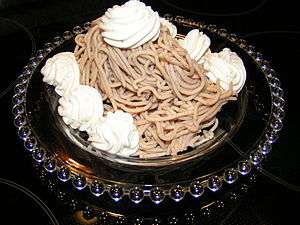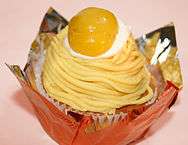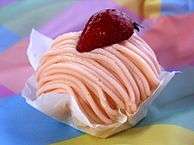Mont Blanc (dessert)
A Mont Blanc (or Mont-Blanc aux marrons) is a dessert of sweetened chestnut purée in the form of vermicelli, topped with whipped cream. It was created in nineteenth-century Paris. The name comes from Mont Blanc, as the dish resembles a snow-capped mountain.
 Mont Blanc | |
| Type | Dessert |
|---|---|
| Place of origin | France |
| Main ingredients | Chestnuts, whipped cream |
Summary
Mont Blanc has been an autumn and winter favorite at many Parisian pâtisseries, notably the Parisian tea shop Angelina, where it has been a specialty since it opened in 1903. For a long time considered old-fashioned and heavy, it has become newly popular in the 2010s in a lighter form at trendy shops like Pierre Hermé, with many variations.[1][2]
Mont Blanc is popular in France, Italy, Hong Kong, Shanghai, Japan, Slovakia, Switzerland, Hungary, and northwestern Romania.
History
Chestnut purées have a long history as a soup, porridge, or side dish for meats, especially in regions where chestnuts are a staple food.[3][4][5][6] However, these dishes are not desserts, and are not served with whipped cream. Even a Swiss or German recipe of whole chestnuts cooked with cream and butter and seasoned with cinnamon is treated as a savory dish in 1844.[7]
The Mont Blanc has three distinctive characteristics: it is sweet, it is made of chestnut purée in the form of vermicelli served as a mount or a ring, and it is heaped with whipped cream.
A sweet dessert of puréed chestnuts passed through a sieve to make vermicelli shapes—but without the characteristic whipped cream of the Mont Blanc—is called in various French cookbooks starting in 1842 (compote de) marrons en vermicelle.[8][9][10] [11]
A dish called entremets du Mont-Blanc or simply montblanc, described as a sweet combination of chestnuts and cream, is said to have been invented by the Dessat(s) pastry-shop by 1847. Sources do not specify exactly how it was prepared, but it was said to be "a true monument which will make his name immortal, that is, a dish that all mouths will praise".[12][13][14]
An unambiguous reference to the Mont Blanc is a dish of puréed chestnuts topped with whipped cream documented in 1885, called torche aux marrons, and considered an Alsatian dish.[15] That recipe does not specify that the chestnuts are formed into vermicelli, but an 1892 article does, and clearly says that torche is the Alsatian name for what is called Mont Blanc in southern France.[16] The same dish is also called marrons chantilly in 1889.[17]
The dish with whipped cream and the name Mont-Blanc aux marrons appears in 1888,[18] 1889,[19] and 1893,[20] and then in Escoffier's Guide Culinaire in 1903, with the advice to pile the whipped cream up irregularly to imitate a rugged mountain.[21]
According to the Mont-Blanc (Monburan) pastry shop in Tokyo, Mont Blanc was introduced to Japan in 1933, inspired by the Mont Blanc of Angelina in Paris. That shop used chestnuts preserved in syrup, which were yellow.[22]
It has been claimed that the dessert was described in Platina's De Honesta Voluptate in 1475, and that a recipe is found in Scappi's Opera in 1570,[23] but no such recipe appears in these writings. It is also claimed that it arrived in France from Italy in 1620, but no evidence is given for this.[2]
Preparation
Mont Blanc may be made from chestnuts cooked in a light syrup or in milk, or they may be cooked in plain water, and the sugar added afterwards.[24] It may also be made with ready-made canned crème de marrons, a purée of the broken chestnuts left over from the manufacture of marrons glacés.[25]
The chestnut purée is generally formed into a ring or cone, with big dollops of whipped cream dropped irregularly into or onto the middle, to resemble snow.[24]
Variations
The chestnut purée may be formed in a mold rather than into vermicelli shapes, though this tends to make the dish heavier.[24] This may be what was called "timbale de marrons, Chantilly" on an 1868 menu.[26]
The original version served multiple diners, but the pâtisserie version today is often an individual serving.[1]
In France, it is sometimes presented on a meringue or biscuit bottom.[1] It may be flavored or garnished with chocolate, rose syrup, berries, and so on.[1]
Variations include using chestnuts in the meringue or biscuit base, with no purée.
Escoffier also describes a Mont-Blanc aux fraises, essentially whipped cream studded with fraises des bois, with no chestnuts at all, the name referring to its shape.[21]
A simplified version mixes crème de marrons with crème fraîche and serves it in a bowl, with no "mountain".[27]
In Japan, sometimes pumpkin, squash, and purple yam are used instead of chestnuts, and along with chestnuts, sometimes cocoa or matcha are added. There are also fruit Mont Blanc, with flavors such as mango and strawberry. In fact, all they have in common with the original is being made of a purée formed into vermicelli shapes.[22]
 French Mont Blanc with chocolate sauce
French Mont Blanc with chocolate sauce Japanese Mont Blanc atop a small cake
Japanese Mont Blanc atop a small cake Japanese Strawberry Mont Blanc
Japanese Strawberry Mont Blanc
See also
Notes
- Lucile Escourrou, "Le Mont Blanc : ce grand classique gourmand de l'hiver", Le Figaro Madame Cuisine January 9, 2015
- Katia Fache-Cadoret, "L'histoire du Mont-Blanc, la pâtisserie hivernale par excellence", Marie-Claire, October 16, 2019
- Gillian Riley, The Oxford Companion to Italian Food, 2007, ISBN 0198606176, s.v., p. 118
- Giacomo Castelvetro, Gillian Riley, translator, The Fruit, Herbs, & Vegetables of Italy, 1989, ISBN 067082724X, p. 125
- "Potage à la purée de marrons", recipe in André Viard, Le cuisinier impérial, Paris, 1806, p. 14
- "Rump with Chestnuts", recipe in "A Lady", Domestic economy, and cookery, for rich and poor, London, 1827, p. 323
- "Châtaignes à la crème", recipe in Jourdan Lecointe, Le cuisinier des cuisiniers, Paris, 1844, p. 438
- A. Chevrier, Nouveau manuel complet du maître-d'hôtel, 1842, p. 17
- M. Étienne, Traité de l'office, 1845, p. 101
- Jules Gouffé, Le livre des conserves, 1900 p. 249
- Jules Trousset, ed., Grande encyclopédie illustrée d'économie domestique et rurale, 1900, p. 899
- Comtesse E. de Ch[ambord], "Modes", La Sylphide : journal de modes, de littérature, de théâtres et de musique II:5, January 3, 1847, p. 35
- La Mode : revue politique et littéraire 18, March 26, 1847, p. 75, p. 336
- The Dessat(s) pastry-shop, rue de Choiseul, Paris, was the successor of "the famous Muot", who is said to be the inventor of the mazarine, a pastry which was famous at the time.
- Jean de Paris, "Un conseil par jour", Le Figaro, December 15, 1885, p. 3
- "Coin des ménagères", La Femme 14:5, March 1, 1892, p. 37
- Jenny Touzin, François-Victor Foveau de Courmelles, La sauce, la cuisine chez soi, 1889, p. 411
- Maître Pierre, "Les Recettes de Maître Pierre", La Petite Presse, 22:7916, January 10, 1888, p. 3
- C. Asserollette (pseudonym of Mme. E. Servie), serialization of her Ma Cuisine (1890) in L'Univers illustré, 32:1812, December 14, 1889, p. 794
- Mme. D. Seignobos, Le Livres des petits ménages, 1893, p. 425
- A. Escoffier, Le Guide Culinaire, 1903, p. 726
- "The Mystery of Mont Blanc", Rei-Saionji
- Daniel Rogov, Yael Hershberg, Rogues, writers & whores : dining with the rich & infamous, 2007, ISBN 1592641725, p. 31
- Marie Ébrard, La Cuisine de Madame Saint-Ange, 1927, p. 934
- Gourmet 54:7-12:226
- Urbain Dubois, Émile Bernard, La cuisine classique, 1868, p. xxvi
- "Mont-blanc", Elle, no date